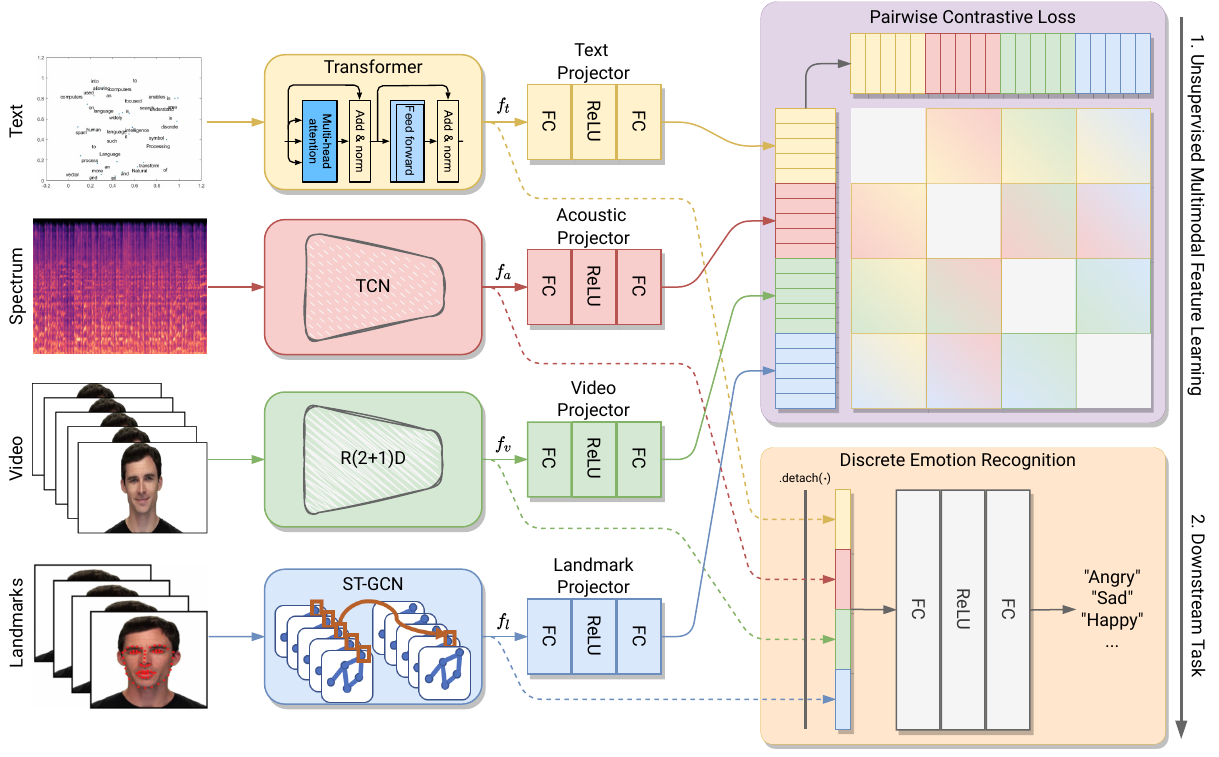This is the official repository for the paper:
Multimodal Emotion Recognition with Modality-Pairwise Unsupervised Contrastive Loss
Riccardo Franceschini,Enrico Fini,Cigdem Beyan,Alessandro Conti,Federica Arrigoni,Elisa Ricci
ICPR 2022
Paper: [ArXiv]
Official implementation of "Multimodal Emotion Recognition with Modality-Pairwise Unsupervised Contrastive Loss", ICPR2022
Abstract: Emotion recognition is involved in several real-world applications. With an increase in available modalities, automatic understanding of emotions is being performed more accurately. The success in Multimodal Emotion Recognition (MER), primarily relies on the supervised learning paradigm. However, data annotation is expensive, time-consuming, and as emotion expression and perception depends on several factors (e.g., age, gender, culture) obtaining labels with a high reliability is hard. Motivated by these, we focus on unsupervised feature learning for MER. We consider discrete emotions, and as modalities text, audio and vision are used. Our method, as being based on contrastive loss between pairwise modalities, is the first attempt in MER literature. Our end-to-end feature learning approach has several differences (and advantages) compared to existing MER methods: i) it is unsupervised, so the learning is lack of data labelling cost; ii) it does not require data spatial augmentation, modality alignment, large number of batch size or epochs; iii) it applies data fusion only at inference; and iv) it does not require backbones pre-trained on emotion recognition task. The experiments on benchmark datasets show that our method outperforms several baseline approaches and unsupervised learning methods applied in MER.
Particularly, it even surpasses a few supervised MER state-of-the-art.

Summary of our approach.. We first learn the multimodal features in an unsupervised fashion, then the downstream task (discrete emotion recognition) is performed. We jointly train, each possible pair of modalities' backbone using contrastive loss in order to predict the correct pairings of a batch of training examples. The final loss is the average of all losses calculated. During inference, f_t, f_a, f_v, f_l are extracted before the projection layers (i.e., fc+RELU+fc) and concatenated, then feed to a linear classifier for emotion recognition.
Acknowldgement: This work was supported by the EU H2020 SPRING project (No. 871245) and by Fondazione VRT.
Our implementation is based on PyTorch. Logging is performed using Wandb. We recommend using conda to create the environment and install dependencies:
conda create --name mpuc-mer python=3.8
conda activate mpuc-mer
conda install pytorch==1.7.1 torchvision==0.8.2 cudatoolkit=XX.X -c pytorch
pip install wandb sklearn tqdm
Currently there are implemented and supported to the latest code version
- CMU-MOSEI -> (http://multicomp.cs.cmu.edu/resources/cmu-mosei-dataset/)
- RAVDESS -> (https://smartlaboratory.org/ravdess/)
To run the code is necessary to pass a configuration file. Two configuration files for the two dataset are available in the config folder. To run the code you can simply use the following command:
python main.py --config config/params_RAVDESS.yaml --device cuda:0 --dataset RAVDESS --output /path/to/log/folder --wandb True
An example of a config file for CMU-MOSEI
dataset:
path_train : "/path/to/train"
path_test : "/path/to/test"
path_valid : "/path/to/validation"
n_frames: 30
classes : 6
text: True
video: True
audio: True
graph: True
model_params:
out_feat: 512
backbone: "STCGN"
adj_matr : "/path/to/adj.npy"
training:
lr_encoder : 0.001
lr_linear : 0.001
batch_size : 32
scheduler_step : 5
scheduler_gamma : 0.9
wd : 0.001
momentum : 0.9
epochs : 2000
patience : 50
num_workers : 2
contrastive: True
unsupervised: True
The model and training sections are common among all the setting while the dataset change depending on the dataset used.
For example in RAVDESS, since the split are not standard it is necessary to specify the split_percentage and if the split has to be performed considering the actor split or not and so on.
dataset:
path : "/path/to/ravdess/"
path_audio : "/path/to/ravdess_audio"
n_frames: 90
n_mels : 128
classes : 8
actor_split: True
text: False
video: False
audio: True
graph: True
split_percentage: 0.9
If you like our work, please cite our paper:
@misc{https://doi.org/10.48550/arxiv.2207.11482,
doi = {10.48550/ARXIV.2207.11482},
url = {https://arxiv.org/abs/2207.11482},
author = {Franceschini, Riccardo and Fini, Enrico and Beyan, Cigdem and Conti, Alessandro and Arrigoni, Federica and Ricci, Elisa},
keywords = {Computer Vision and Pattern Recognition (cs.CV), Artificial Intelligence (cs.AI), Machine Learning (cs.LG), Multimedia (cs.MM), FOS: Computer and information sciences, FOS: Computer and information sciences},
title = {Multimodal Emotion Recognition with Modality-Pairwise Unsupervised Contrastive Loss},
publisher = {arXiv},
year = {2022},
}